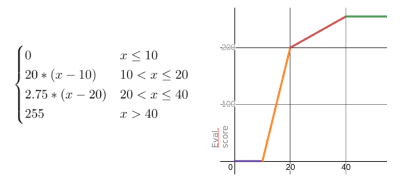Implementation
Play Categorization
Plays can be split effectively by sorting them on the state of the game with respect to the ball. There are 3 states.
Offensive When the ball is in possession of the team, we try to score. We either pass or shoot at goal.
Defensive When the ball is in possession of the enemy team or contested, the play will be to defend the goal and steal the ball.
Referee Specific States that the referee calls upon are states that will only be used in specific plays.
Evaluations
Likewise, ’evaluations’ were added that should hold all evaluations that are needed in the play. Within evaluations, a score is given based on evaluating the input parameters and mapping them to a 0-255 range with a piece-wise linear function. For example, when evaluating the openness of a location, all the distance gathering of the location is done in the computation which refers that information to the evaluation The evaluation will then make a score based on the given parameters (i.e. summing them up) and map the result to the correct range.
